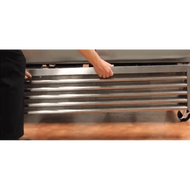Tips for maintaining commercial refrigeration
Published by Prestige Products on 8th May 2014
Following these simple maintenance and cleaning procedures can greatly extend the life and efficiency of your refrigerated cabinet. Knowing what you need to do will keep your cabinet running efficiently now and for years to come and will save you money in unnecessary repair costs and downtime. All refrigerated equipment can benefit from these procedures.
On Arrival:
Upon arrival and after moving into position, please ensure the cabinet is left for at least one hour before connecting to power and turning on. Ensure all packaging material has been removed before turning the power on. Some fridges may have packaging material in the motor compartment, to protect the pipes or some components in transport. If not checked or removed, these may interfere with the operation of the motor. Read the instruction manual and make yourself familiar with the features and operting instructions of your cabinet.
Ventilation:
Always ensure the cabinet is installed in a room with adequate ventilation. Refrigerators generate considerable amount of heat and if operated in a small unventilated room especially in warm weather it can create excessive temperature in the room. Do not block vents by stacking boxes on top or in front of the unit as this will result in recirculation of heated air generated by the condenser and would adversely affect performance. This would cause the condensing unit to work longer and harder to maintain cabinet temperature therefore having a detrimental effect on all components and increased energy consumption. You must allow enough access for service and maintenance as well as discharge of waste heat. In addition to ventilation in the room please ensure that cabinets with top mounted motor have 500mm clearance between the top of the cabinet and the ceiling. For all cabinets please ensure a minimum clearance of 50mm is provided around the unit to ensure efficient and effective performance.
Positioning:
The cabinet should be positioned in a well ventilated area and in a level position to ensure correct operation of self-closing doors and proper drainage of condensate from the evaporator.
Loading:
Before loading the fridge with any products allow cabinet to reach normal operating temperature. When normal operating temperature has been reached, ensure
the load is equally distributed throughout and air can circulate around and through stored products. Stored products in the cabinet should ideally
be refrigerated prior either in a blast chiller, in a back of house coolroom or refrigerated delivery. Outside these parameters, only ambient products
should be placed in the fridge. Never introduce heated products inside the cabinet as this would cause icing of the evaporator which in turn will increase
internal cabinet temperature
making condensing unit work longer and harder. The thermometer should be checked daily to ensure the correct temperature is being maintained. If the
stored products are temperature sensitive, a temperature monitoring system or alarm should be considered.
Door Lock:
If the cabinet is fitted with a door lock it is recommended that locking key is removed from lock during normal working use. This will prevent bending or breaking of the key which could result in lock having to be replaced. Removing the key also prevents any possibility of accidentally locking when the door is open. This will prevent the door from closing probably and will cause interior temperature to rise and the evaporator to ice up.
Cleaning:
If cabinet exterior is looked after correctly it will retain its new finish for many years. Normal day-to-day cleaning should be carried out with a soft cloth and soapy water. For cabinets with stainless steel finish, always wipe the cabinet in the same direction as the grain. Whilst stainless steel finish is robust, the satin smooth finish can be spoilt by wiping against the grain. Never use abrasive cleaning materials or chemical cleaners. These can damage the surface and cause corrosion. Occasionally exterior surface should be polished with a good stainless steel polisher or protector. Interior should be cleaned regularly with warm soapy water and a soft cloth and dried thoroughly afterwards. Where possible remove all racking and shelving for thorough cleaning.
Door gaskets:
Gaskets are designed to keep the cool in and the warmth out by sealing the door against the fridge wall and creating an insulated space between the two which is vital to the efficiency of your unit. Therefore the door gaskets should be checked and cleaned regularly and replaced if damaged. Clean the gasket with a warm soapy water and a soft cloth ensuring it is completely dry before closing the door. Do not use a sharp knife to clean or straighten the gasket.
Condenser:
Dusty condenser coils cause a cabinet to work harder and struggle to maintain temperature which translates in bigger energy bills and shorter life expectancy. To prevent this from happening the condenser requires cleaning approximately four times per year. To clean, disconnect from the main supply before starting. Some fridges are fitted with a removable cassette that slides out. If this is the case, slide out the cassette. Take care not to damage any electrical connections and cables during the removing and the cleaning process. Brush vents vertically with a soft brush. Take care not to damage fins or to push dirt further in and vacuum away. If there are further grease deposits still remaining on the condenser call your service provider to carry out full service.
Evaporator:
Most fridges rely on a drain whole and drip pans to remove condensation so it's important that these function properly. Inspect these periodically to
ensure that there is no blockage.
We recommend regular preventive maintenance using a qualified service provider to ensure your investment is running in optimum conditions and peak performance.

